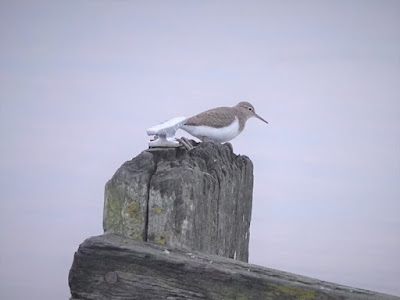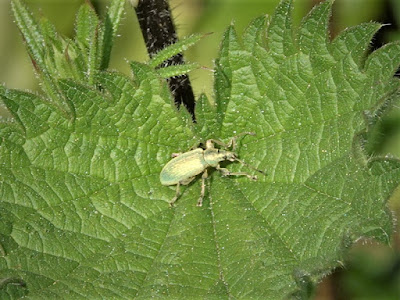11.0°C > 15.0°C: Low overcast soon breaking with good sunny spells. Light westerly wind. Very good visibility.
Sunrise: 05:28 BST
Photos from today will be added to this blog post tomorrow: apologies – I have succumbed to jet-lag!
Priorslee Balancing Lake: 05:10 – 06:45 // 07:50 – 09:25
Priorslee Balancing Lake: 05:10 – 06:45 // 07:50 – 09:25
(92nd visit of the year)
Bird notes:
- Not sure how many gosling Canada Geese there were: at least four
- The Cetti's Warbler was again very vocal and mobile though I heard it move all along the South and West sides and it seems only one bird is involved. Desperately searching for a mate?
- Two singing Sedge Warblers is a more reasonable number.
- Ten Starlings were noted feeding on the grass verge in Teece Drive.
Birds noted flying over here:
- 2 Canada Geese: together
- 2 Feral Pigeons: together
- 13 Wood Pigeons
- 1 Black-headed Gull
- 3 Lesser Black-backed Gulls
- 1 Common Buzzard
Warblers noted (the number singing in brackets):
- 1 (1) Cetti's Warbler
- 2 (2) Willow Warblers again
- 12 (11) Chiffchaffs
- 2 (2) Sedge Warblers
- 14 (14) Reed Warblers
- 16 (15) Blackcaps
- 1 (1) Garden Warbler
- 2 (2) Common Whitethroats
Hirundines etc., noted:
- 7 Swifts
- 1 Barn Swallow
Counts from the lake area:
- 4 + 4? (1 brood) Canada Geese: the resident pair with goslings; another pair visited briefly
- 2 Mute Swans
- 3 (2♂) Mallard
- 2 (2♂) Tufted Duck
- 4 Moorhens
- 23 + 2 (1 brood) Coots
- 7 Great Crested Grebes
- 2 Common Sandpipers again
On the street lamp poles pre-dawn:
Bird notes:
- Not sure how many gosling Canada Geese there were: at least four
- The Cetti's Warbler was again very vocal and mobile though I heard it move all along the South and West sides and it seems only one bird is involved. Desperately searching for a mate?
- Two singing Sedge Warblers is a more reasonable number.
- Ten Starlings were noted feeding on the grass verge in Teece Drive.
Birds noted flying over here:
- 2 Canada Geese: together
- 2 Feral Pigeons: together
- 13 Wood Pigeons
- 1 Black-headed Gull
- 3 Lesser Black-backed Gulls
- 1 Common Buzzard
Warblers noted (the number singing in brackets):
- 1 (1) Cetti's Warbler
- 2 (2) Willow Warblers again
- 12 (11) Chiffchaffs
- 2 (2) Sedge Warblers
- 14 (14) Reed Warblers
- 16 (15) Blackcaps
- 1 (1) Garden Warbler
- 2 (2) Common Whitethroats
Hirundines etc., noted:
- 7 Swifts
- 1 Barn Swallow
Counts from the lake area:
- 4 + 4? (1 brood) Canada Geese: the resident pair with goslings; another pair visited briefly
- 2 Mute Swans
- 3 (2♂) Mallard
- 2 (2♂) Tufted Duck
- 4 Moorhens
- 23 + 2 (1 brood) Coots
- 7 Great Crested Grebes
- 2 Common Sandpipers again
On the street lamp poles pre-dawn:
Nothing seen
Noted later:
- Small White butterfly (Pieris rapae)
- Speckled Wood butterfly (Pararge aegeria)
- unidentified ichneumon / wasp
- possible Tawny Mining Bee (Andrena fulva)
- another mining bee sp.
- Red-tailed Bumblebee (Bombus lapidarius)
- Large Red Damselfly (Pyrrhosoma nymphula) *** apparently a new species for me here ***
- Cheilosia albitarsus agg. (C. ranunculi (Early Buttercup Cheilosia) or C. albitarsis (Late Buttercup Cheilosia))
- Common Dronefly (Eristalis tenax)
- Alder Fly (Sialis lutaria)
- Dock Bug (Coreus marginatus)
- Nettle Weevil (Phyllobius pomaceus)
- Garden Snail (Cornu aspersum aka Helix aspersa)
- Bird Cherry flowers (Prunus padus)
- Red Campion flowers (Silene dioica or Melandrium rubrum)
On the ceiling and one wall of the Priorslee Avenue tunnel:
- 11 midges of c,4 species.
- 1 owl midge Psychodidae sp.
- 1 White-legged Snake Millipede (Tachypodoiulus niger)
- 1 unidentified slug sp.
Between the lake and The Flash:
- Moorhen with at least three juveniles on the lower pool.
Noted later:
- Small White butterfly (Pieris rapae)
- Speckled Wood butterfly (Pararge aegeria)
- unidentified ichneumon / wasp
- possible Tawny Mining Bee (Andrena fulva)
- another mining bee sp.
- Red-tailed Bumblebee (Bombus lapidarius)
- Large Red Damselfly (Pyrrhosoma nymphula) *** apparently a new species for me here ***
- Cheilosia albitarsus agg. (C. ranunculi (Early Buttercup Cheilosia) or C. albitarsis (Late Buttercup Cheilosia))
- Common Dronefly (Eristalis tenax)
- Alder Fly (Sialis lutaria)
- Dock Bug (Coreus marginatus)
- Nettle Weevil (Phyllobius pomaceus)
- Garden Snail (Cornu aspersum aka Helix aspersa)
- Bird Cherry flowers (Prunus padus)
- Red Campion flowers (Silene dioica or Melandrium rubrum)
On the ceiling and one wall of the Priorslee Avenue tunnel:
- 11 midges of c,4 species.
- 1 owl midge Psychodidae sp.
- 1 White-legged Snake Millipede (Tachypodoiulus niger)
- 1 unidentified slug sp.
Between the lake and The Flash:
- Moorhen with at least three juveniles on the lower pool.
One of the two Common Sandpipers present. Disturbance later prevented me getting closer.
A rare sighting of two Swifts in close formation. These highly aerial birds are usually weaving their individual path across the sky as they pursue their insect prey.
The presence of both the Common Buzzard and a trio of Lesser Black-backed Gulls was only revealed by the noise from the upset gulls as they chased the buzzard away.
I hope to do better on another day: this is the only shot I managed of a Common Whitethroat.
The Garden Warbler was slightly more cooperative. Slightly. Note the black and, for a warbler, rather strong bill.
An unusual sighting of a male Blackcap singing out in the open.
One of about ten Starlings feeding amongst many expired dandelion stems alongside Teece Drive.
This Speckled Wood (Pararge aegeria) was my first butterfly of the year here.
Closely followed by a Small White butterfly (Pieris rapae). The feint black spot on the upper-wing and plain under-wing indicate it is a male. Females have an obvious single black spot in both their upper- and lower-wings.
The long antennae means this is a bee rather than a fly. I don't have much experience with mining bees (Andrena sp.).
The body shape of this individual suggests it is a different species of mining bee.
I think this is an Ashy Mining Bee (Andrena cineraria).
Four species of mining bee in one day?! This seems to be a Tawny Mining Bee (A fulva).
I am even less experienced with nomad bees. I think this is a Lathbury's Mining Bee (Nomada lathburiana).
Bumblebees are rather easier. Here is a Red-tailed Bumblebee (Bombus lapidarius).
Almost all Cheilosia hoverflies are difficult to identify. Its habitat suggests this might be either C. ranunculi (Early Buttercup Cheilosia) or C. albitarsis (Late Buttercup Cheilosia)).
The markings on this Common Drone Fly (Eristalis tenax) are more extensive than usual. Its size and robust body seem to preclude it being any other species.
Rather better lighting on today's Alder Fly (Sialis lutaria).
I think this rather attractive fly is one of the Blow-flies (Calliphoridae). I cannot identify the species.
My first Nettle Weevil (Phyllobius pomaceus) of the year.
Also a year-first was this Dock Bug (Coreus marginatus).
Well it is not in your garden so admire this Garden Snail (Cornu aspersum aka Helix aspersa) for what it is!
A white flower that I overlooked on Saturday was this from a Bird Cherry (Prunus padus).
Not all the flowers are white: this is Red Campion (Silene dioica or Melandrium rubrum).
These are flowers of Green Alkanet (Pentaglottis sempervirens). Many are growing along the bank of the football field. It would be good to think that the council will respect 'no mow May' and let these attractive flowers set seen and proliferate.
(Ed Wilson)
The Flash: 06:55 – 07:40
------------------------------------------------------------------------------------------------------
The Flash: 06:55 – 07:40
(84th visit of the year)
Another addition to my 2023 bird list from here. A Reed Warbler was singing along the East side where the footpath that passes the small play area meets the circular path. This takes my count to 67.
Other bird notes:
- No Greylag Geese goslings seen. It is likely they were inside the island.
- Yesterday's brood of Mallard ducklings was right against the island and impossible to count accurately: at least six.
- The brood of five Coot juveniles seen yesterday was reduced to four today. The single well-grown juvenile was not seen but likely present somewhere.
- A Great Spotted Woodpecker was heard calling at the top end.
Birds noted flying over here:
- 2 Jackdaws
Warblers noted (the number singing in brackets):
- 5 (5) Chiffchaffs again
- 6 (4) Blackcaps
- 1 (1) Reed Warbler
Hirundines etc., noted:
Another addition to my 2023 bird list from here. A Reed Warbler was singing along the East side where the footpath that passes the small play area meets the circular path. This takes my count to 67.
Other bird notes:
- No Greylag Geese goslings seen. It is likely they were inside the island.
- Yesterday's brood of Mallard ducklings was right against the island and impossible to count accurately: at least six.
- The brood of five Coot juveniles seen yesterday was reduced to four today. The single well-grown juvenile was not seen but likely present somewhere.
- A Great Spotted Woodpecker was heard calling at the top end.
Birds noted flying over here:
- 2 Jackdaws
Warblers noted (the number singing in brackets):
- 5 (5) Chiffchaffs again
- 6 (4) Blackcaps
- 1 (1) Reed Warbler
Hirundines etc., noted:
None
Noted on / around the water
- 18 Canada Geese
- 4 Greylag Geese
- 2 + 1 Mute Swans: ? eggs
- 13 (10♂) + 6? (1 brood) Mallard: see notes
- 1 (1♂) all-white duck (Peking(?) Duck)
- 4 (3♂) Tufted Duck
- 5 Moorhens
- 22 + 4 (1 brood) Coots
- 2 Great Crested Grebes
On / around the street lamp poles
Noted on / around the water
- 18 Canada Geese
- 4 Greylag Geese
- 2 + 1 Mute Swans: ? eggs
- 13 (10♂) + 6? (1 brood) Mallard: see notes
- 1 (1♂) all-white duck (Peking(?) Duck)
- 4 (3♂) Tufted Duck
- 5 Moorhens
- 22 + 4 (1 brood) Coots
- 2 Great Crested Grebes
On / around the street lamp poles
Nothing noted
Of interest elsewhere:
- Common Drone Fly (Eristalis tenax)
- Alder Leaf Beetle (Agelastica alni)
Of interest elsewhere:
- Common Drone Fly (Eristalis tenax)
- Alder Leaf Beetle (Agelastica alni)
This more typically marked Common Drone Fly (Eristalis tenax) was the only thing that troubled the camera here this morning.
(Ed Wilson)
------------------------------------------------------------------------------------------------------
On this day can be found via the yearly links in the right-hand column.
Sightings from previous years without links are below
2013
Nedge Hill
Yellow Wagtail
3 Wheatear
(John Isherwood)
2012
Wrekin
2 Wood Warblers
4 Pied Flycatchers
(Mike Stokes)
2011
Nedge Hill
2 Wheatear
(John Isherwood)
2008
Priorslee Lake
18 Mute Swans
(Martin Adlam)
2006
Priorslee Lake
Pair of Ruddy Ducks
(Ed Wilson)



























